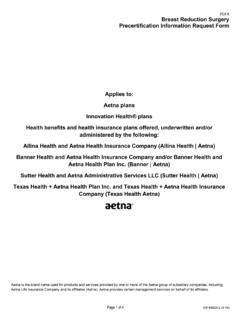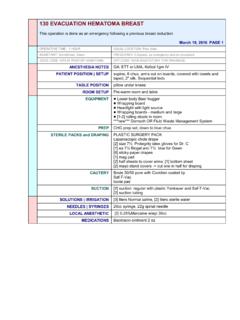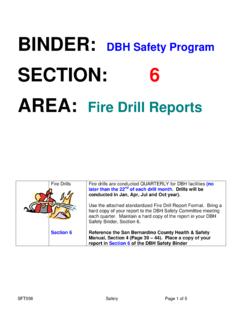Transcription of 13. NUTRIENT MINERALS IN DRINKING WATER: …
1 16413. NUTRIENT MINERALS IN DRINKING water : IMPLICATIONS FOR THE NUTRITION OF INFANTS AND YOUNG CHILDREN Erika Sievers Institute of Public Health North Rhine Westphalia Munster, Germany _____ I. INTRODUCTION The WHO Global Strategy on Infant and Young Child Feeding emphasizes the importance of infant feeding and promotes exclusive breastfeeding in the first six months of life. In infants who cannot be breast-fed or should not receive breast milk, substitutes are required. These should be a formula that complies with the appropriate Codex Alimentarius Standards or, alternatively, a home-prepared formula with micronutrient supplements (1).
2 DRINKING water is indispensable for the reconstitution of powdered infant formulae and needed for the preparation of other breast-milk substitutes. As a result of the long-term intake of a considerable volume in relation to body weight, the concentrations of NUTRIENT MINERALS in DRINKING water may contribute significantly to the total trace element and mineral intake of infants and young children. This is especially applicable to formula-fed infants during the first months of life, who may be the most vulnerable group affected by excessive concentrations of nutrients or contaminants in DRINKING water .
3 Defining essential requirements of the composition of infant formulae, the importance of the quality of the water used for their reconstitution has been acknowledged by the Scientific Committee on Food, SCF, of the European Commission (2). Although it was noted that the mineral content of water may vary widely depending upon its source, the optimal composition remained undefined. Recommendations for the composition of infant formulae refer to total NUTRIENT content as prepared ready for consumption according to manufacturer s instructions. However, these usually inform the consumer about the quantity of powder and DRINKING water required as well as other technical advice for the reconstitution of the formula, but do not refer to the mineral concentration in DRINKING water itself.
4 The use of desalination to provide DRINKING water may continue to increase all over the world. Remineralization of mineral content in waters that have been treated by demineralization may provide an opportunity to improve compositional choices. Specific aspects of vulnerable groups have to be considered, but the needs of infants and young children, especially if nourished with infant formula instead of human milk, may be of special concern. The question arises whether special NUTRIENT mineral properties of these waters should be considered for use for infants and young children.
5 II. ASSESSMENT OF mineral INTAKE IN INFANT NUTRITION Public health decisions about the composition of infant foods and the use of DRINKING water in infancy require awareness of the approaches used in the study methodology applied to nutrition trials in infancy and early childhood. These approaches may be of crucial importance in the interpretation of the results and potential limitations of their significance for the issues raised. 165 Analytical results of infant formulae may only refer to analyses of the powder itself or formulae prepared under standardized laboratory conditions with defined water (3).
6 Metabolic studies investigating mineral bioavailability have attempted to exclude or minimize the potential influences of different water supplies, (4). They therefore have been performed either in the clinic, on metabolic wards, or at home using a standardized water supply or ready-to-feed liquid infant formula. On the other hand, recently published epidemiological trials concerning mineral supplementation in infancy neither assess representative mineral concentrations in the DRINKING water at a household level or the quantitative water intake (5-7). For example, investigations concerning the effects of copper concentrations in DRINKING water , analyzed neither the respective nutrition nor representative specimens (8).
7 Finally, studies addressing both DRINKING water and powdered infant formula referred to the concentrations given by the manufacturer, but analysed the reconstituted formula, too (9). III. THE QUANTITATIVE INTAKE OF DRINKING water IN INFANCY AND EARLY CHILDHOOD Health and well-being in early childhood are dependent on an optimal supply of essential nutrients. NUTRIENT requirements for growth necessitate intake and positive retention of essential trace elements and MINERALS . The immaturity of homeostatic mechanisms in gastrointestinal and renal functions of resorption and excretion also raises a concern over the susceptibility to an excess or a deficiency of nutrients as well as to toxic substances during this crucial period for mental and motor development.
8 A major factor in the NUTRIENT mineral intake from DRINKING water is the quantity of water consumed. 1. The Choice of Nutrition a significant Factor of DRINKING water Intake in Infancy In considering the consumption of DRINKING water by vulnerable populations, a figure of litres per day has been used for a 5kg child and a figure of one litre per day for a 10kg child (10). Although these figures may be applicable for standard calculations, the range of quantitative water intake observed in populations at that age might be considerable according to the Food and Nutrition Board of the Institute of Medicine (11).
9 The choices made in terms of how an infant is fed, especially in the first six months of life, are significant factors in determining the level of NUTRIENT mineral intake from DRINKING water : Healthy, exclusively breast-fed infants nourished according to present recommendations (1) will not directly consume DRINKING water in the first six months of life. They might eventually be indirectly affected by a potential passage of (trace) MINERALS into human milk. Unfortunately, sometimes the early introduction of supplementary feedings of water , tea or other nutrients is practised.
10 After six months, the introduction of complementary foods and breastfeeding for up to two years of age or beyond is recommended. During this period, household DRINKING water intake will depend on the extent of breastfeeding and on whether complementary foods are prepared at home or bought commercially. Healthy infants fed powdered infant formula consume DRINKING water from the day they are born owing to the fact that it is used to reconstitute the product. Both may contribute to the mineral intake up until complementary foods are introduced. Different sources of water may be used, including tap water , well water , and natural bottled mineral water labelled as suitable for infant nutrition.














